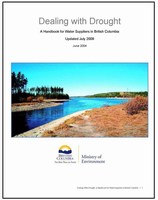Dealing with Drought: A Handbook for Water Suppliers in British Columbia (July 2009)
Dealing with Drought
 In June 2004, the Ministry of Environment released the original version of Dealing with Drought: A Handbook for Water Suppliers in British Columbia. This followed the drought of 2003. The Handbook was prepared with the support and assistance of the Union of British Columbia Municipalities. An updated version was released in July 2009.
In June 2004, the Ministry of Environment released the original version of Dealing with Drought: A Handbook for Water Suppliers in British Columbia. This followed the drought of 2003. The Handbook was prepared with the support and assistance of the Union of British Columbia Municipalities. An updated version was released in July 2009.
The handbook was prepared for the province and its communities with a two-part vision: 1) to provide proactive drought management goals to help prevent the onset of drought conditions, and 2) to assist and support water suppliers with assessing, planning, and responding to drought conditions and coordinating internal and external communications.
A Message from the Minister
“The hot, dry summers of recent years, and 2003 in particular, brought home the message that we shouldn’t take our water supply for granted. We need to change our  way of thinking about our valuable water resource to ensure we are protecting water for communities, for economic development and for the sustainability of fish and aquatic ecosystems. By working together, we can better plan for the conservation of our water resource,” states Environment Minister Barry Penner in the foreword to the July 2009 update.
way of thinking about our valuable water resource to ensure we are protecting water for communities, for economic development and for the sustainability of fish and aquatic ecosystems. By working together, we can better plan for the conservation of our water resource,” states Environment Minister Barry Penner in the foreword to the July 2009 update.
About the 2009 Update
“The current long, hot, dry summer which much of the province is experiencing has highlighted the need to conserve water and plan for drought, adds Donna Caddie, Living Water Smart Project Manager and a member of the Innovation & Planning Team, Water Stewardship Division of the BC Ministy of Environment.
“The Drought Handbook is designed to assist local water suppliers in dealing with drought management and water conservation planning. It provides proactive drought management goals to help prevent the onset of drought conditions, and assists water suppliers to assess, plan, and respond to drought conditions and coordinate internal and external communications.”
The Living Water Smart website provides helpful tips about easy actions to reduce water use, inside and outside the house.

